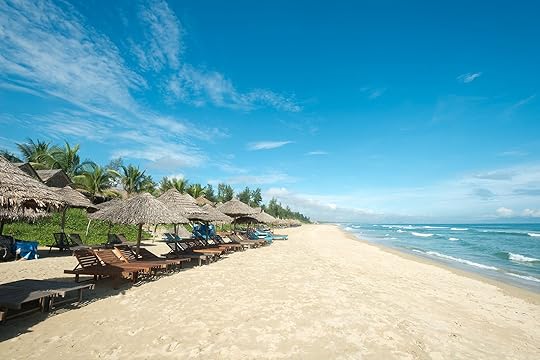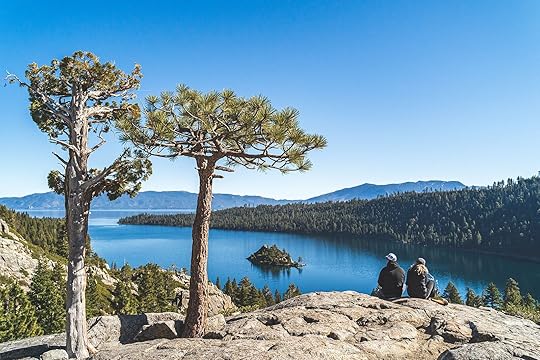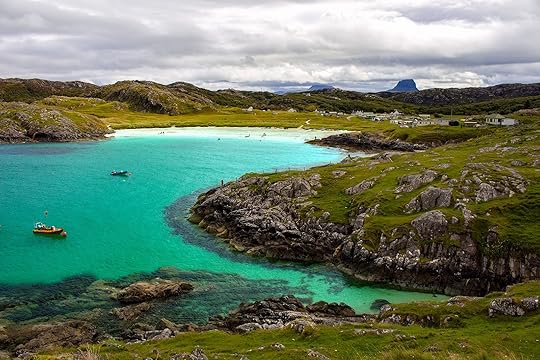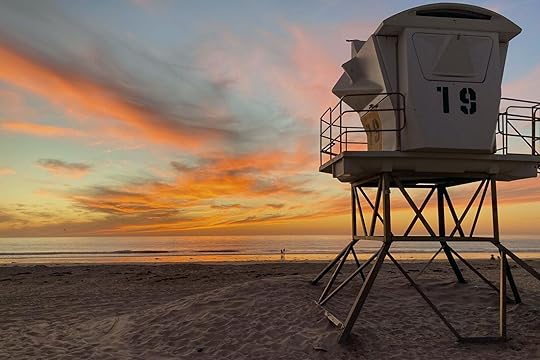From Piha to The Split: Matador’s 11 Favorite Beaches Around the World

Ask 10 people what the “best beach” is and you’re likely to get 10 different answers. Sure, there are big-name best beach lists, but “best” is inherently subjective when it comes to beaches around the world. Sometimes it’s a spot far off the beaten path, other times it’s a popular beach that has under appreciated aspects many people miss.
From Scottish coves to Vietnamese shores, this list reflects the Matador Network team’s favorite beaches based on collective decades of travel — places that we find ourselves referencing time again when we’re asked for where to go. These aren’t ranked, and they’re not always the most famous stretches of sand in their regions. What they share is that they particularly stand out in our memories, and you may find the same.
Ang Bang Beach | Emerald Bay State Park | Beaches of Lizard Island | Parc National des Calanques | Achmelvich Beach | Cathedral Cove | The Split | Miami Beach | Mission Beach | Tajiguas | Güvercinlik BeachAng Bang Beach in Hoi An, Vietnam Photo: Chris Howey/Shutterstock
Photo: Chris Howey/Shutterstock Photo: Likee68/Shutterstock
Photo: Likee68/Shutterstock Photo: Ryasnik/Shutterstock
Photo: Ryasnik/ShutterstockAt Ang Bang Beach, the sand is golden, the water a deep turquoise, and the vibe unapologetically old-school. The setting embodies the fairytale charm of Hoi An’s historic town center, where brightly burning paper lanterns float down the Thu Bon River at sunset and cyclists make their way down canal-lined corridors, bike baskets filled with fresh banh mi. Here, on the coast of the East Vietnam Sea (don’t irk the locals by calling it the South China Sea), fishermen push off from the shore in the iconically circular thúng chai boats, and street vendors hawk snacks and drinks to guests relaxing on umbrella-covered wooden lounge chairs.
My wife and I honeymooned in Hoi An and spent our days in this manner, a sweating bottle of Bia Saigon never far from our hands. Occasionally, we’d wander into the water that felt warm on our skin and pushed waves softened by the barrier islands just visible on the horizon. Neither of us is a “water person” (we’re from Colorado) but Ang Bang Beach has become our reference point for judging beaches when we visit them. Ten years on and we’ve yet to find one as unique, as memorable, or as beautiful. — Tim Wenger, transactional content editor
Emerald Bay State Park near Lake Tahoe, California Photo: Suzie Dundas
Photo: Suzie Dundas Photo: Hakan Ozturk/Shutterstock
Photo: Hakan Ozturk/Shutterstock Photo: RandomHartz/Shutterstock
Photo: RandomHartz/ShutterstockDespite being a pretty avid scuba diver, I actually don’t like swimming in the ocean much. I’d rather float around in calm water with no waves and no sea creatures flittering around my feet. So I’m lucky to live close to one of my favorite beaches: the shoreline at Emerald Bay State Park, on the southwestern side of Lake Tahoe. It sits in a gorgeous, pine-lined cove surrounding Tahoe’s only island: Fannette Island, a boulder-covered land mass rising from the blue-green water. Reaching the beach involves hiking down a one-mile trail with a 400-foot drop, which means you also have to hike 400 feet to get back out. That doesn’t keep the crowds down much, but it does mean the beach is surrounded on all sides by tree-covered forest ridgelines.
From Emerald Bay, you can chill in the water all day, relax on the beach, rent kayaks (summer only) from the on-site rental shop, or hike the 8-mile Rubicon Trail. At the other end are the almost-as-beautiful beaches of DL Bliss State Park. The shore-hugging trail to get there shows off Tahoe at its finest.
Emerald Bay State Park doesn’t offer much in the way of amenities, so bring your own food, drink, towels, and anything you may want (though washrooms and drinking water are available in the summer). Traffic around Emerald Bay is some of the worst in Tahoe, and you need to get there by 7 AM or so to get a parking space. Fortunately, local conservation group Keep Tahoe Blue just introduced a reservable round-trip shuttle to Emerald Bay, running every day from the start of summer to mid-October. You can jump on in South Lake Tahoe, or from the north near Tahoma. The shuttle makes accessing the park any day you want – and any time you want – much more convenient, and eliminates the headache of sitting in traffic and circling until you can find a spot. — Suzie Dundas, commissioning editor
Beaches of Lizard Island in Australia Photo: Darios/Shutterstock
Photo: Darios/Shutterstock Photos: Suzie Dundas
Photos: Suzie Dundas Photo: Darios/Shutterstock
Photo: Darios/ShutterstockIf you want to feel like a celebrity for a few days, start planning a trip to Lizard Island, on Australia’s Great Barrier Reef. The private island has sequestered stretches of white sand accessible primarily to guests of Lizard Island Resort, its research station, and a small campground. The island’s beaches offer a sense of privacy and isolation that’s hard to find elsewhere on the reef. Guests can hike to secluded coves, snorkel around rocky reefs just off the main beach, or even post up at a sprawling beach used as a filming location for David Attenborough’s Great Barrier Reef. Nearly every beach is flanked by granite boulders and lush, tropical vegetation.
Getting there isn’t easy or cheap. Lizard Island Resort is considered one of the most private and exclusive resorts in the country, with just 40 rooms and suites that open to the beach. You’ll have to arrive by charter boat or charter flight, unless you have your own boat and can make your way to a buoy near the island’s laid-back Marlin Bar. If you’re not staying at the resort (and you’re not affiliated with the research station), the only option is to camp. You’ll need a permit from the Queensland National Park Booking Service, and must be totally self-sufficient. The only amenity is the Marlin Bar, which is open just two days a week. — SD
Parc National des Calanques near Marseille, France Photo: Andre Quinou/Shutterstock
Photo: Andre Quinou/Shutterstock Photo: marako85/Shutterstock
Photo: marako85/Shutterstock Photo: marako85/Shutterstock
Photo: marako85/ShutterstockSome parts of the Côte d’Azur feel like a supermodel — eye-wateringly beautiful but a little superficial. Then there’s Marseille. Marseille has opinions. It’s the pixie dream girl of the south coast: gritty, gorgeous, and wild. It’s also a short drive away from France’s first peri-urban national park, Parc National des Calanques. The Calanques begin less than eight miles from the Vieux-Port but feel like another planet.
The calanques are a chain of steep, narrow inlets carved into the limestone coast. Some are wide enough for little fishing boats to moor in the turquoise shallows. Others are slivers of pebble beach reachable by dusty, steep trails strewn with pine needles.
One of my favorites is Calanque de Marseilleveyre — one of the easiest to reach if you don’t have a boat. That said, you still need to trek in. The hike starts in Callelongue, a sleepy fishing hamlet with a handful of old cottages and a tiny port. From there, the stony path dips and climbs along the edge of the sea. It takes about an hour without stops, but the indescribable views make that hard.
When you finally drop down into the calanque, it’s just a small arc of pebbles and clear water where you can cool off. Bring cash for grilled fish and a cold glass of rosé at Chez Le Belge, a relaxed beachside shack. Most people make a day of it — partly because of the effort to get there, but also because the cliffs shift from pale gray to warm gold as the sun moves across the sky. — Katie Gavin, editor
Achmelvich Beach in Scotland Photo: organtigiulia/Shutterstock
Photo: organtigiulia/Shutterstock Photo: Attila Vanyo/Shutterstock
Photo: Attila Vanyo/Shutterstock Photo: Alexisaj/Shutterstock
Photo: Alexisaj/ShutterstockMany Scots words translate easily into English, but dreich – meaning dull, gloomy, or dreary weather – captures a spirit no English word quite can. And dreich my country is. It’s one of the wettest places in Europe. The west coast, where some of our finest beaches are, is particularly prone to a downpour. But when we do have blue skies, the white sand and glassy turquoise water along Scotland’s coastline rival the Mediterranean.
Fortunately for those relying on tourism, this is no longer a secret to our neighbors down south or visitors from overseas (thanks, TikTok). However, as a local trying to make the most of a rare sunny day by the sea, it can be frustrating to find crowds of visitors navigating huge RVs down the single-track roads to our now not-so-secret beaches.
One of the prettiest is Achmelvich Beach, located near Lochinver in Sutherland, about 40 miles north of Ullapool. Achmelvich is a sheltered bay on the remote west coast. The main beach is a wide crescent of soft white sand, broken up by granite outcrops. The water here is crystal clear. I usually bring my paddleboard, and when the sea is calm, it’s worth paddling out for a stunning view of the hills rising behind the dunes. Get here early to beat the selfie-stick crowd and to appreciate just how spectacular Scotland is when the sun comes out. — KG
Cathedral Cove in New Zealand Photo: superjoseph/Shutterstock
Photo: superjoseph/Shutterstock Photo: Filip Fuxa/Shutterstock
Photo: Filip Fuxa/Shutterstock Photo: superjoseph/Shutterstock
Photo: superjoseph/ShutterstockBorn and raised in Mexico City, I always took pride in Mexico’s beaches. They were the standard by which I measured every stretch of coastline I visited — and they almost always stand out. That perspective shifted completely the moment I arrived in New Zealand.
The coastline of Aotearoa is far from the postcard version of paradise that has coconut palms and beach huts selling ice-cold drinks. Like the rest of the country, New Zealand’s beaches are wild and imposing, offering experiences that feel anything but ordinary: the black-sand stretches of Piha and the wild surf of Muriwai, the wind-sculpted coves of Wharariki and the geothermal sands of Hot Water Beach.
Yet every time I think about the New Zealand coast, I think of the same spot: Cathedral Cove. Located on the eastern side of the Coromandel Peninsula, north of Auckland, you get to the beach via a 45-minute hike through coastal forest filled with towering tree ferns, pōhutukawa trees, and dense native undergrowth that feels almost prehistoric. The views along the trail offer a preview of what’s waiting at sea level: soft white sand, turquoise water, and massive limestone formations that wouldn’t look out of place in Avatar’s Pandora.
The beach’s most iconic feature is a towering limestone arch that splits the shoreline and perfectly frames the cliffs and ocean beyond. Its Māori name, Te Whanganui-A-Hei (“the great bay of Hei”), refers to a Polynesian navigator and spiritual leader who arrived in Aotearoa and claimed this bay for his descendants, recognizing its abundance and spiritual significance.
There are no services beyond the parking lot — except for a set of mid-trail toilets — so plan ahead and bring everything you’ll need for the day. It’s a bit of a journey, but the reward is one of the most unforgettable beaches you’ll ever visit. — Rulo Luna, photo editor
The Split near Caye Caulker, Belize Photo: Aleksandar Todorovic/Shutterstock
Photo: Aleksandar Todorovic/Shutterstock Photo: Kelsey Wilking
Photo: Kelsey Wilking Photo: JC Cuellar/Shutterstock
Photo: JC Cuellar/ShutterstockThe Split is a narrow channel cutting through the middle of Caye Caulker, stretching about 180 yards across and connecting the north and south sides of the island. Legend has it that a fisherman first carved a path through the mangroves in the 1950s to improve boat access, and the channel was later widened by Hurricane Hattie’s damage in 1961. Since then, it’s evolved into one of Belize’s most iconic swimming spots. The sea-glass water is calm through the strait, bordered by white sand and anchored by the low-key bar The Lazy Lizard. Half-submerged plastic chairs, a jump-off platform, and weathered picnic tables make it easy to spend all day doing nothing. This is a place that invites you to slow down — something rare in a world that’s always rushing to be first in line. It’s not glamorous or pretentious, and it doesn’t try to be. And that’s the point. Like all favorite places, it’s how it makes you feel that sticks.
Outside of floating through the channel and sipping brightly colored cocktails, there’s plenty to explore within walking distance of The Split. Snorkel tours to the world’s second-largest barrier reef offer the chance to swim alongside lemon sharks, manatees, sea turtles, and schools of brilliantly colored fish. Just a barefoot walk away is Stingray Beach, where, unsurprisingly, rays glide right up to the shoreline for a gentle pet and a photo op. After sunset, take a seat at a picnic table at Wish Willy’s, where a local grills fresh conch in his backyard and serves cold beer from the cooler. For something more adventurous, book a night snorkeling tour to see the bioluminescent glow in the water and spot the after-dark activity of lobsters, octopus, and squid. — Kelsey Wilking, email marketing specialist
Miami Beach in Florida Photo: Gino Santa Maria/Shutterstock
Photo: Gino Santa Maria/Shutterstock Photo: Sean Pavone/Shutterstock
Photo: Sean Pavone/Shutterstock Photo: Fokke Baarssen/Shutterstock
Photo: Fokke Baarssen/ShutterstockAs a Miami Beach local, I think to myself “I already have this in my backyard” anytime I head to pristine beaches in the Caribbean. On a perfect beach day, Miami’s waters are crystal clear, with schools of fish darting to and fro — all set against a backdrop of Art Deco boutique hotels framed by swaying palm trees. The key is to catch that perfect day. A good start is avoiding the tourist crowds on weekends, holidays, and during annual events like Art Basel, Ultra Music Festival, or Spring Break. Try a morning bike ride on the boardwalk to spot a low-key area to lay your towel down and take a dip. — Keven Gungar, Matador Creators manager
Mission Beach in San Diego Photo: Keven Gungor
Photo: Keven Gungor Photo: Spearhead Media LLC/Shutterstock
Photo: Spearhead Media LLC/Shutterstock Photo: KishoreJ/Shutterstock
Photo: KishoreJ/ShutterstockTime to visit: Anytime except winter
Atmosphere: calm, surfy, youthful, family-friendly
Best thing to do: go for a boardwalk stroll & watch the sunset
The most gorgeous sunsets I’ve ever seen were in San Diego. In Mission Beach, sunset-watching is a ritual. Families, friends, and couples nestle up on the beach or bike down the boardwalk to catch stunning solar hues. Beyond the sunsets, Mission Beach always feels like something out of an early 2000s music video: a quintessential American beach town with surfers on one side and beach volleyball players on the other, and kids racing off to the local amusement park, Belmont Park. The one catch is people don’t really swim casually in the ocean off Southern California the way they do in warmer waters like the Caribbean. If you’re someone who loves everything about “beach culture” except for actually getting in the water, then this is the kind of place for you. — KG
Tajiguas Beach near Goleta, CaliforniaView this post on InstagramA post shared by Bob Pullen (@smorgasphoto)
Growing up on the California Central Coast meant having no shortage of beaches to choose from any time of year. That said, the popular ones like Refugio, Avila Beach, and Pismo were always too popular — even 15 years ago before “overtourism” became a common term. Even Jalama Beach, tucked away behind a 30 minute windy drive on a small road with no service, had enough people that parking was a nightmare in almost any season. Tajiguas has built in crowd control that shot it to the top my favorite beach list then and now: just a handful of unmarked parking spots on the side of the Pacific Coast Highway, then a short hike past railroad tracks and down a cliffside that’s unfriendly to anything with wheels.
Tajiguas doesn’t have any facilities or infrastructure, and the sand is clean outside of the occasional pile of earthy smelling kelp (always pack out what you pack in). The waves and riptide can get strong, so swimming should be limited to people confident in the water, but the cold Pacific is refreshing on a hot day. Keep an eye out for gray, blue, and humpback whales that can be spotted from the shore depending on the season. At low tide, you can walk until your legs wear out. One side has rocks and a smattering of tidepools that lead to a wave break wall you can balance across — just keep an eye on the water. Speaking from experience, it’s a rough swim around rocks to get back to the sand below the parking area if you get caught by the encroaching high tide. Tajiguas isn’t a “hidden gem” or secret beach, but it does scratch the itch for anyone wanting a public beach that feels hyper-local and private. — Nickolaus Hines, managing editor
Güvercinlik Beach, Türkiye
Photo: Nickolaus Hines
I’ve made plenty of memories on the Mediterranean beaches of Spain, Italy, France, and Greece. Few stick with me as much as the the stretch of beach in the town of Güvercinlik in a small bay. I drove there from Istanbul on a family trip in early fall, and stayed at a stunning Airbnb with access to the water. During the hot days, I would take my toddler and jump off the dock into the refreshing water clear enough to see down to the sand more than 10 feet down (and all the fish in between the surface and sand). The water is calm enough for the most casual of kayaking most of the day. When we wanted a change of scenery, my wife and I would stroller our kid the short walk past the sand beaches and umbrellas to the strip of restaurants where we picked our locally caught fish from a pile of ice and ordered a bottle of Turkish white wine to leisurely sip at our own pace as the flood of meze filled the table before the main course. (Favorites included Balıkçı Hasan Restaurant 1985, Doy Doy Balık Restaurant, and Ziyafet Pide Recep Usta’nın Yeri.) Sunsets are as stunning as the sunrise, and the crowds are small and tend toward being more local. — NH 
Matador Network's Blog
- Matador Network's profile
- 6 followers



